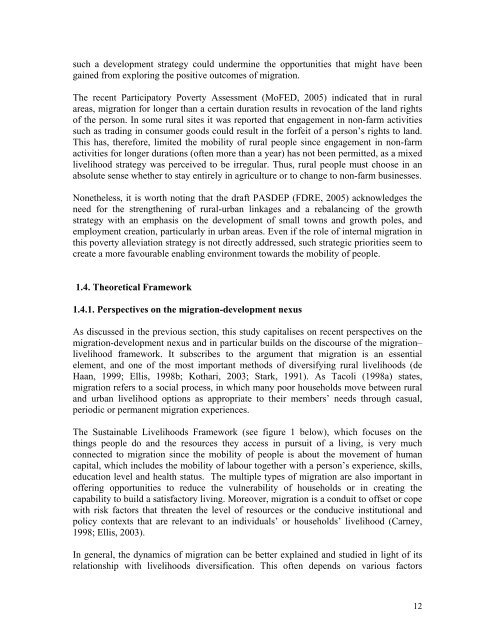Migration and Rural-Urban Linkages in Ethiopia
Migration and Rural-Urban Linkages in Ethiopia - Ethiopian Review
Migration and Rural-Urban Linkages in Ethiopia - Ethiopian Review
You also want an ePaper? Increase the reach of your titles
YUMPU automatically turns print PDFs into web optimized ePapers that Google loves.
such a development strategy could underm<strong>in</strong>e the opportunities that might have beenga<strong>in</strong>ed from explor<strong>in</strong>g the positive outcomes of migration.The recent Participatory Poverty Assessment (MoFED, 2005) <strong>in</strong>dicated that <strong>in</strong> ruralareas, migration for longer than a certa<strong>in</strong> duration results <strong>in</strong> revocation of the l<strong>and</strong> rightsof the person. In some rural sites it was reported that engagement <strong>in</strong> non-farm activitiessuch as trad<strong>in</strong>g <strong>in</strong> consumer goods could result <strong>in</strong> the forfeit of a person’s rights to l<strong>and</strong>.This has, therefore, limited the mobility of rural people s<strong>in</strong>ce engagement <strong>in</strong> non-farmactivities for longer durations (often more than a year) has not been permitted, as a mixedlivelihood strategy was perceived to be irregular. Thus, rural people must choose <strong>in</strong> anabsolute sense whether to stay entirely <strong>in</strong> agriculture or to change to non-farm bus<strong>in</strong>esses.Nonetheless, it is worth not<strong>in</strong>g that the draft PASDEP (FDRE, 2005) acknowledges theneed for the strengthen<strong>in</strong>g of rural-urban l<strong>in</strong>kages <strong>and</strong> a rebalanc<strong>in</strong>g of the growthstrategy with an emphasis on the development of small towns <strong>and</strong> growth poles, <strong>and</strong>employment creation, particularly <strong>in</strong> urban areas. Even if the role of <strong>in</strong>ternal migration <strong>in</strong>this poverty alleviation strategy is not directly addressed, such strategic priorities seem tocreate a more favourable enabl<strong>in</strong>g environment towards the mobility of people.1.4. Theoretical Framework1.4.1. Perspectives on the migration-development nexusAs discussed <strong>in</strong> the previous section, this study capitalises on recent perspectives on themigration-development nexus <strong>and</strong> <strong>in</strong> particular builds on the discourse of the migration–livelihood framework. It subscribes to the argument that migration is an essentialelement, <strong>and</strong> one of the most important methods of diversify<strong>in</strong>g rural livelihoods (deHaan, 1999; Ellis, 1998b; Kothari, 2003; Stark, 1991). As Tacoli (1998a) states,migration refers to a social process, <strong>in</strong> which many poor households move between rural<strong>and</strong> urban livelihood options as appropriate to their members’ needs through casual,periodic or permanent migration experiences.The Susta<strong>in</strong>able Livelihoods Framework (see figure 1 below), which focuses on theth<strong>in</strong>gs people do <strong>and</strong> the resources they access <strong>in</strong> pursuit of a liv<strong>in</strong>g, is very muchconnected to migration s<strong>in</strong>ce the mobility of people is about the movement of humancapital, which <strong>in</strong>cludes the mobility of labour together with a person’s experience, skills,education level <strong>and</strong> health status. The multiple types of migration are also important <strong>in</strong>offer<strong>in</strong>g opportunities to reduce the vulnerability of households or <strong>in</strong> creat<strong>in</strong>g thecapability to build a satisfactory liv<strong>in</strong>g. Moreover, migration is a conduit to offset or copewith risk factors that threaten the level of resources or the conducive <strong>in</strong>stitutional <strong>and</strong>policy contexts that are relevant to an <strong>in</strong>dividuals’ or households’ livelihood (Carney,1998; Ellis, 2003).In general, the dynamics of migration can be better expla<strong>in</strong>ed <strong>and</strong> studied <strong>in</strong> light of itsrelationship with livelihoods diversification. This often depends on various factors12




![to read the full report [pdf, Amharic] - Ethiopian Review](https://img.yumpu.com/52737829/1/190x245/to-read-the-full-report-pdf-amharic-ethiopian-review.jpg?quality=85)











